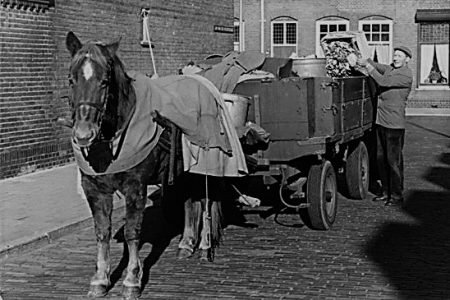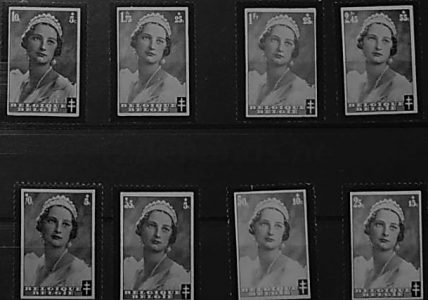
QUEEN ASTRID OF BELGIUM
Written by Bert Plomp
On one of my rounds past the trash cans, I made the find of my life. It was on Breitner Lane that I opened a bin and found a large bag full of stamps. I couldn’t believe my eyes. There were a few thousand stamps. In the end, there were no expensive ones among them, but the pile certainly guaranteed weeks of large bags of fries with mayonnaise and bottles of cola.
My friend Joop stood by me during this find. Once home with the loot, we divided it fairly. It took too much time to split the bag stamp by stamp. So we took turns grabbing a handful from the stamp mountain. Part of my portion of the mountain ended up in my collection. The less interesting stamps went into albums for the stamp market. The least interesting ones I put in a leftover bag.
If it wasn’t ’trash can day’ and my friends and I were walking from school to home, we were often up to mischief. Teasing the residents of Breitner Lane. What we found fun was pulling newly planted boxwood bushes out of the ground. We would then place those bushes in front of someone’s door, ring the bell, and run away as fast as we could. Every now and then, one of us would be caught and receive a good beating. But when the garbage collector did his rounds, we went completely wild. Residents would leave their potato peels, usually wrapped in a newspaper, ready for collection next to their door. After the collector had deposited the peels on his cart, he would return the paper packaging to the door. The collector used the collected peels as feed for his animals. When my friends and I came home from school on ‘peel day’, we would follow the horse’s trail step by step. Here and there, we would pick up the horse’s droppings from the street with a newspaper. Occasionally, you would see a resident, standing in front of the living room window, nodding approvingly. However, a little further down the street, we would deposit the packaged horse droppings in front of another resident’s door. There we would set the newspaper on fire and ring the bell. Then we would watch from a distance as the lady of the house rushed outside in panic. Stamping her feet, she would hastily try to extinguish the fire.
In my youth, I was an avid stamp collector. It was also a lot of fun to do some trading with those paper franks. The fact that those stamps came from far and wide, from all parts of the world, greatly captured my imagination. My German stamps mostly dated from the Nazi era. When I looked at those stamps, I could see and hear the SS marching. I also had a wide range of stamps from former Dutch East Indies. When I saw those stamps from the Emerald Belt, I always thought of a very beautiful, slender, indigenous girl with long, black hair. I often tried to imagine whose tongue had touched the back of the stamp. Even then, the indigenous girl often came to mind.
On the shopping square of Napoleon Plantsoen, there was a grocery store. That store was simply referred to as ‘Van de Rijst’. That was the grocer’s last name. Rob, the grocer’s son, was in charge of the family’s stamp collection. That was the reason why Joop and I had invited him to come over to show us the beautiful stamps he guarded. In Joop’s room, we subjected the ‘Van de Rijst collection’ to expert judgment. To Rob’s great disappointment, our judgment was that his collection wasn’t anything special. When Rob, to cope with this setback, went to the toilet for a glass of water, Joop and I thought it a good idea to do some stamp trading. To transfer some stamps from the family collection to ours. To generously compensate the family for that, we placed a much larger number of stamps from our leftover bag in the grocer’s collection. The reasoning behind this unsolicited exchange was very simple. Joop and I, and other neighbours, believed that shopkeepers were doing well enough. They could bear a small loss. I experienced such a strange thinking and behaviour many years later in a very different situation. It concerned a transaction of much larger scale. Good friends of mine, who owned several works by a befriended painter, asked him if he was willing to take back one of the paintings and sell it for them. Jean, the painter, agreed to do so. When the sale took an exceedingly long time, Jean was asked how it was going. My friends were somewhat worried. After two years of waiting, they had heard from other friends that the painting had been sold more than a year ago. To the justified question about the money, Jean replied nonchalantly: Oh, you surely don’t need that money. As a poor artist, I need it much more. Well, you know what they say about friends.
In our neighbourhood lived a family named Wilstra. The Wilstras also had stamps. Oldest son Rudi was in charge of the collection. Rudi was also given the opportunity to show us the treasures he had at home. We studied the family’s possessions very carefully. To our great surprise, we discovered that one of the albums contained the complete ‘Mourning Series of Queen Astrid of Belgium’. It was as if we had found a painting by Rembrandt somewhere in an attic. Like Rob, Rudi also had to take a break to use the bathroom. That restroom break gave Joop and me the opportunity for an urgent consultation. Upon Rudi’s return from the toilet, he was made an offer he couldn’t refuse: Queen Astrid in exchange for a whole bag of stamps. Rudi eagerly grabbed the leftover bag with both hands and left Astrid behind with us. Rudi couldn’t wait to get home with the bag of stamps and announce the big news of the successful transaction. Decades have passed since then. Recently, I asked Joop if he still had Astrid under his care. He confirmed it. His wife didn’t mind.

